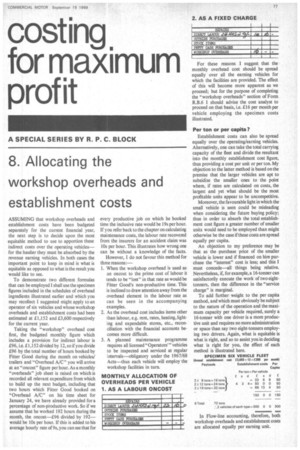8. Allocating the workshop overheads and establishment costs
Page 83

If you've noticed an error in this article please click here to report it so we can fix it.
ASSUMING that workshop overheads and establishment costs have been budgeted separately for the current financial year, the next step is to decide upon the most equitable method to use to apportion these indirect costs over the operating vehicles— for the haulier they must be absorbed by the revenue earning vehicles. In both cases the important point to keep in mind is what is equitable as opposed to what is the result you would like to see.
To demonstrate two different formulas that can be employed! shall use the specimen figures included in the schedules of overhead ingredients illustrated earlier and which you may recollect 1 suggested might apply to an operator of six vehicles and whose workshop overheads and establishment costs had been estimated at £1,152 and £3,600 respectively for the current year.
Taking the "workshop" overhead cost first, the budgeted monthly figure which includes a provision for indirect labour is £96, i.e. £1,152 divided by 12, so if you divide £96 by the total number of hours booked by Fitter Good during the month on vehicles/ trailers and "Overhead A/C" you will arrive at an "oncostfigure per hour. As a monthly "overheads" job sheet is raised on which is recorded all relevant expenditure from which to build up the next budget, including that two hours which Fitter Good booked on "Overhead A/C" on his time sheet for January 24, we have already provided for a percentage of non-productive work. So if we assume that he worked 192 hours during the month, the oncost—£96 divided by 192— would be lOs per hour. If this is added to his average hourly rate of 9s, you can see that for
every productive job on which he booked time the inclusive rate would be 19s per hour. If you refer back to the chapter on calculating maintenance costs, the labour rate recovered from the insurers for an accident claim was lOs per hour. This illustrates how wrong one can be without a knowledge of the facts.
However, I do not favour this method for three reasons:—
I. When the workshop overhead is used as an oncost to the prime cost of labour it tends to be "lost" in that rate as would be Fitter Good's non-productive time. This is inclined to draw attention away from the overhead element in the labour rate as can be seen in the accompanying examples.
2. As the overhead cost includes items other than labour, e.g. rent, rates, heating, lighting and expendable stores, etc., reconciliation with the financial accounts becomes more difficult.
3. A planned maintenance programme requires all licensed "Operators" vehicles to be inspected and serviced at regular intervals—obligatory under the 1967/68 Acts—thus each vehicle will employ the workshop facilities in turn. For these reasons I suggest that the monthly overhead cost should be spread equally over all the earning vehicles for which the facilities are provided. The effect of this will become more apparent as we proceed; but for the purpose of completing the "workshop overheads" section of Forrn R.B.6 I should advise the cost analyst to proceed on that basis, i.e. £16 per month per vehicle employing the specimen costs illustrated.
Per ton or per capita?
Establishment costs can also be spread equally over the operating/earning vehicles. Alternatively, one can take the total carrying capacity of the fleet and divide the resultant into the monthly establishment cost figure, thus providing a cost per unit or per ton. My objection to the latter method is based on the premise that the larger vehicles are apt to subsidize the smaller ones to the point where, if rates are calculated on costs, the largest and yet what should be the most profitable units appear to be uncompetitive.
Moreover, the favourable light in which the small vehicle is seen could be misleading when considering the future buying policy; thus in order to absorb the total establishment cost figure a greater number of smaller units would need to be employed than might otherwise be the case if these costs are spread equally per capita.
An objection to my preference may be that as the .purchase price of the smaller vehicle is lower and if financed on hire purchase the "interest" cost is less; and this I must concede—all things being relative. Nevertheless, if, for example, a 16-tonner can satisfactorily execute the work of two eighttonners, then the difference in the "service charge" is marginal.
To add further weight to the per capita method, and which must obviously be subject to the nature of the operation and the maximum capacity per vehicle required, surely a 16-tonner with one driver is a more productive unit and requires no more administration or space than say two eight-tonners employing two drivers. Again, what is equitable is what is right, and so to assist you in deciding what is right for you, the effect of each method is illustrated here.












































































































































